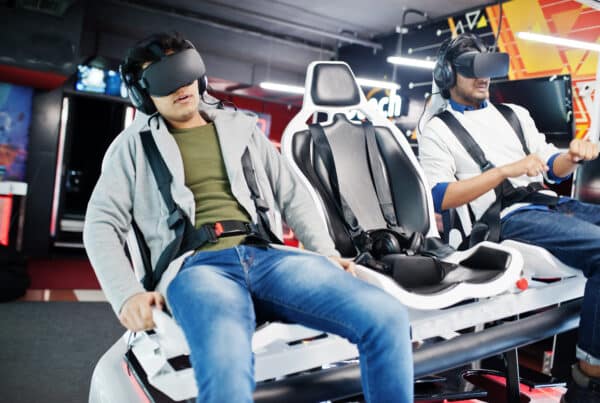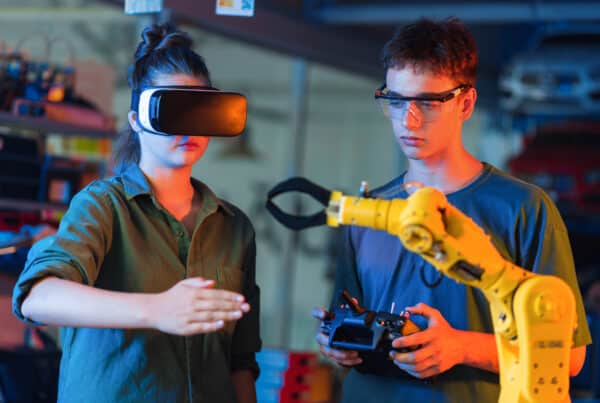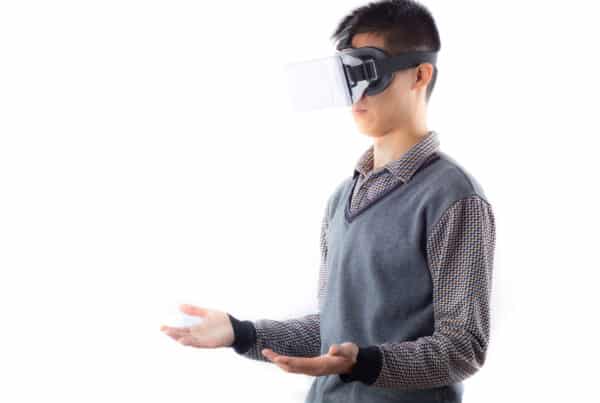
Introduction to Projection Augmented Models (PAMs)
Hey there! Have you ever wondered how digital elements can seamlessly blend into our physical world without the need for clunky headsets or glasses? Welcome to the fascinating universe of Projection Augmented Models (PAMs), a branch of technology that brings augmented reality (AR) to life through the magic of projection. Let’s embark on this journey to explore how PAMs are reshaping our interaction with digital content in real-world environments.
Definition of Projection Augmented Reality (PAR)
Projection Augmented Reality (PAR) is a captivating technology that projects digital images onto physical surfaces, creating an interactive and immersive experience. Unlike traditional AR, which often requires wearable devices like glasses or headsets, PAR uses projectors to overlay digital information directly onto real-world objects. This approach enhances our surroundings with digital overlays, transforming ordinary spaces into extraordinary interactive environments.
Key Differences Between Traditional AR and Projection-Based AR
While traditional AR relies heavily on personal devices, projection-based AR eliminates the need for individual wearables. Instead, it uses projectors to cast digital content onto surfaces, allowing multiple users to experience the augmented environment simultaneously. This shared experience is a game-changer, making AR more accessible and engaging for group interactions.
Importance in Enhancing Real-World Environments with Digital Overlays
Projection Augmented Models are revolutionizing how we perceive and interact with our surroundings. By seamlessly blending digital elements with the physical world, PAMs enhance environments in ways that were previously unimaginable. Whether it’s transforming a classroom into an interactive learning hub or turning a retail store into a dynamic shopping experience, the possibilities are endless.
How Projection Augmented Models Work
Now that we’ve set the stage, let’s dive into the mechanics of how Projection Augmented Models operate.
Overview of Projection Mapping Technology
At the heart of PAMs is projection mapping technology. This technique involves projecting images onto irregular surfaces, aligning the digital content perfectly with the physical environment. It’s like painting with light, where projectors become the brush and surfaces the canvas. This precise alignment creates a mesmerizing illusion of digital elements interacting with real-world objects.
Role of Machine Vision and Depth-Sensing Cameras
To achieve this level of precision, PAMs rely on machine vision and depth-sensing cameras. Devices like Kinect and Lightform capture the environment in real-time, mapping the physical space to ensure accurate projection. These cameras analyze depth and contours, allowing digital content to adapt dynamically to changes in the environment, creating an immersive AR experience.
Integration with Physical Objects and Real-Time Environment Mapping
One of the most exciting aspects of PAMs is their ability to integrate with physical objects. By mapping digital overlays onto real-world items, PAMs create a seamless blend of digital and physical elements. This integration allows for real-time interaction, where users can engage with projections directly, without the need for intermediary devices.
Core Components of Projection Augmented Models
Let’s break down the essential components that make PAMs tick.
Projectors
Projectors are the backbone of PAMs, displaying AR content on physical surfaces. Unlike wearable devices, projectors offer a shared experience, allowing multiple users to interact with the augmented environment simultaneously. They bring digital content to life, transforming ordinary spaces into interactive wonderlands.
Depth Cameras
Depth cameras play a crucial role in ensuring precise mapping of projections. By capturing the environment’s depth and contours, these cameras enable accurate alignment of digital content with physical objects. This precision is vital for creating a realistic and immersive AR experience.
Software Integration
Software integration is the glue that holds PAMs together. It enables customization and real-time interaction, making PAMs versatile tools for various industries. From manufacturing to entertainment and retail, software integration allows for tailored experiences that meet specific needs and enhance user engagement.
Applications of Projection Augmented Models
PAMs are making waves across multiple sectors. Let’s explore some of their most exciting applications.
Manufacturing and Industry
In the manufacturing world, PAMs are enhancing assembly lines and training processes. By overlaying digital instructions onto physical workspaces, PAMs provide real-time guidance, improving efficiency and reducing errors. Imagine a factory where workers receive step-by-step instructions projected directly onto their workstations—it’s like having a digital assistant guiding every move!
Retail and Advertising
Retailers are leveraging PAMs to create interactive customer experiences. From virtual fitting rooms to dynamic product displays, projections transform shopping into an immersive adventure. Imagine trying on clothes without changing or seeing a product’s features come to life before your eyes. PAMs make it possible, enhancing customer engagement and satisfaction.
Education and Training
Education is another field where PAMs shine. By creating interactive learning environments, PAMs engage visual and auditory learners, making complex subjects more accessible. Imagine a classroom where historical events unfold through projections or science experiments come to life on the walls. PAMs turn learning into an exciting journey of discovery.
Benefits of Projection Augmented Models
PAMs offer a plethora of benefits, making them a valuable addition to various industries.
Immersive Experiences
By seamlessly blending digital and physical environments, PAMs create shared AR experiences that are both engaging and memorable. They transform ordinary spaces into interactive playgrounds, captivating users and enhancing their interaction with digital content.
Real-Time Interaction
One of the standout features of PAMs is the ability to interact with projections directly, without intermediary devices. This direct interaction fosters a more natural and intuitive user experience, making digital content feel like an integral part of the physical world.
Error Prevention and Process Efficiency
In industries like manufacturing, PAMs provide real-time feedback on processes, helping prevent errors and improve efficiency. By overlaying digital instructions and quality checks onto physical workspaces, PAMs streamline operations and enhance productivity.
Challenges and Limitations
Despite their potential, PAMs face several challenges that need to be addressed.
Environmental and Space Requirements
For effective deployment, PAMs require specific environmental and space conditions. Factors like ambient light and surface texture can impact projection quality, necessitating careful planning and setup.
Limitations of Current Hardware
Current hardware, such as projectors, faces limitations in range and performance under varying conditions. Ambient light interference and limited projection range can affect the quality and effectiveness of PAMs, highlighting the need for ongoing hardware advancements.
Scalability in Larger Environments
Scaling PAMs to larger environments or industries presents challenges. Ensuring consistent projection quality and interaction across expansive spaces requires sophisticated technology and infrastructure.
Future of Projection Augmented Models
The future of PAMs is bright, with innovations on the horizon that promise to address current limitations and expand their capabilities.
Innovations on the Horizon
Emerging technologies like light field systems and more versatile hardware are set to enhance PAMs, offering improved projection quality and interaction. These advancements will pave the way for more immersive and interactive experiences.
Integration with Emerging Technologies
The integration of PAMs with technologies like 5G and AI holds immense potential. Faster data transmission and smarter algorithms will enable more responsive and dynamic projections, further enhancing user experiences.
Potential for Wider Adoption
As technology continues to evolve, PAMs are poised for wider adoption across industries. Their ability to enhance user experiences and improve operational efficiency makes them a valuable tool for businesses and consumers alike.
Conclusion
Projection Augmented Models are revolutionizing how we interact with digital content in physical spaces. By seamlessly blending digital and physical environments, PAMs offer immersive experiences that captivate users and enhance engagement. While challenges remain, ongoing innovations promise to unlock new possibilities and drive wider adoption. As we look to the future, PAMs are set to play a pivotal role in shaping the way we perceive and interact with the world around us.
Discover the power of Projection Augmented Models! Contact Virtually Anywhere today to explore how this cutting-edge technology combines physical models with dynamic digital projections to create immersive, interactive experiences. Whether for education, design, or marketing, projection augmentation brings your ideas to life like never before. Start transforming your presentations today!
People Also Ask
- What are the main applications of projection augmented reality? PAMs are used in manufacturing, retail, education, and more, enhancing processes and creating interactive experiences.
- How is projection augmented reality different from traditional augmented reality? Unlike traditional AR, which requires wearable devices, projection AR uses projectors to overlay digital content onto physical surfaces.
- What technology is used in projection augmented reality? PAMs rely on projectors, depth cameras, and software integration to create immersive experiences.
- How do projection mapping systems work? Projection mapping involves projecting images onto surfaces, aligning digital content with the physical environment for a seamless blend.
- How does projected AR enhance user experience in industries like manufacturing and retail? By providing real-time instructions and interactive displays, projected AR improves efficiency and customer engagement.




